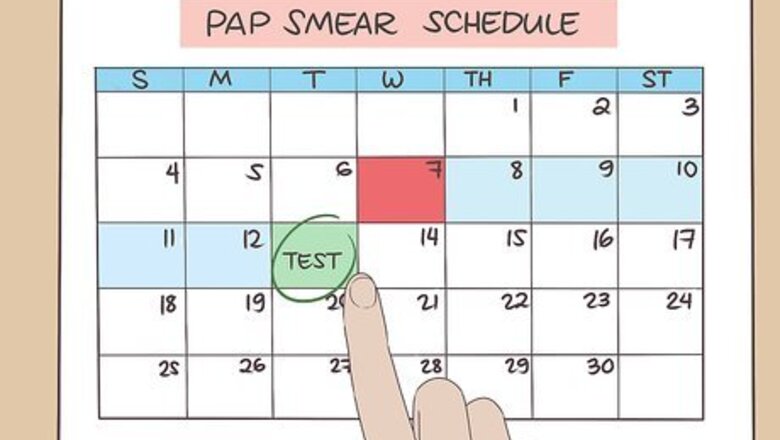
views
X
Trustworthy Source
US Office on Women's Health
U.S. government agency providing resources for women's health
Go to source
It’s natural to be a bit nervous about getting a pap smear done, but this simple procedure is easy to prepare for, quick, and usually only a little uncomfortable. If you’re worried or not sure what to expect, don’t hesitate to ask your doctor or nurse any questions you might have!
Ensuring a Successful Pap Smear

Schedule the test when you won’t be having your period. Since bleeding can make the test a little less accurate, try to get your pap smear done during a time when you won’t be having your period. If possible, do it at least 5 days after your last period ended. If your period comes unexpectedly, don’t worry—you might still be able to get your pap smear. Call your doctor’s office and let them know what’s going on, and they’ll let you know if you need to reschedule. If you have a regular cycle, you can use a calendar or period tracking app (such as Clue or Period Tracker Lite) to track your cycle and predict when your next period is coming.

Avoid putting anything in your vagina for 2 days before the test. Putting anything in your vagina could disturb any abnormal cells in your cervix and make your pap smear results inaccurate. During the 2 days leading up to your test, don’t have vaginal sex, and don’t put any of the following things in your vagina:Keep in mind: It’s never a good idea to use douches or vaginal deodorants, since they can irritate your vagina and cause infections. Stick to washing the area around your vagina with plain soap and water. Douches Vaginal medicines (such as creams or suppositories for yeast infections) Spermicidal foams, creams, or jellies Tampons Vaginal deodorants

Ask if you should pee right before the test. Getting a pelvic exam and pap smear with a full bladder can be really uncomfortable, so it’s always a good idea to go to the bathroom first! Before you go, though, ask your nurse or doctor if it’s okay. Depending on why you’re there, they might want you to collect a urine sample for testing instead of going directly in the toilet. For example, your doctor might take a urine sample if they need to test for pregnancy, a bladder infection, or STIs (sexually transmitted infections). A lot of doctors will ask for a urine sample before the exam, so call ahead to find out if this is something your doctor will want you to do. If you don’t have a full enough bladder when you get to the office, you can ask for water.
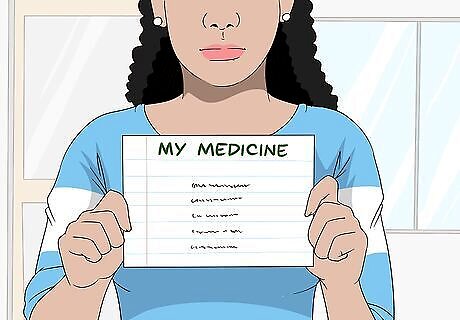
Tell your doctor about any medicines you’re taking. Some kinds of medications, like hormonal birth control pills, can affect your pap test results. Give your doctor a full list of any medicines or supplements you use so that they can interpret your test results as accurately as possible. You should also tell them if: You’ve ever had an abnormal pap test result You’re pregnant or think you might be pregnant You’re allergic to any medications or materials (such as latex) You’ve been having any symptoms that you’re concerned about (like spotting, unusual discharge, rashes, or pain in your pelvis or vagina)
Undergoing the Test

Take off your clothes from the waist down. After taking your medical history, the nurse or doctor will hand you a paper gown or sheet and ask you to take off your shoes, pants, and underwear. They’ll leave the room or draw a curtain so you can get undressed in private. Once you’re undressed, put the gown or sheet on so it covers the front of your body.Tip: At most doctor’s offices, you can request to have a chaperone with you in the room during the exam, such as a nurse or a family member. Sometimes it can be helpful to have someone else in the room if you’re feeling nervous. Sometimes, your doctor might want to do a breast exam as well as a pap smear and pelvic exam. In these cases, they may ask you to take off your top and bra, too. The doctor or nurse will knock on the door or call out to ask if you’re ready before they come back into the room.

Lie down on the exam table and put your feet in the stirrups. Climb onto the exam table and lie down on your back, then put your heels in the stirrups at the end of the table. The doctor will ask you to scoot your butt down so it’s resting right on the edge of the exam table. Relax your legs and allow your knees to fall open. You might feel nervous or embarrassed, and that’s totally normal and okay. Breathe deeply and try to relax as much as possible. This will help you feel calmer and will make it easier for the doctor to perform the exam.
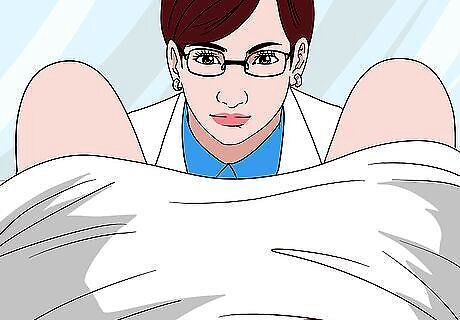
Expect your doctor to examine the outside of your pelvis and vulva. Most of the time, your doctor will want to do a pelvic exam at the same time as your pap smear. They’ll probably start the exam by feeling your belly and pelvic area with their hands, and they will also look at your vulva and the area outside your vagina to check for rashes, redness, or any other signs of problems. Your doctor should explain what they are doing during every step of the exam and pap smear. If you have any questions or don’t feel comfortable with what they’re doing, don’t hesitate to speak up! You will feel the doctor’s gloved hands touching the area around your vagina. They might have to spread the labia (lips) of your vulva so they can get a better look.
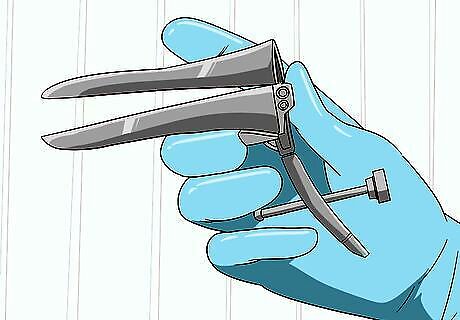
Allow your doctor to insert a lubricated speculum into your vagina. When they’re ready to do the pap smear, your doctor will slide a tool called a speculum into your vagina. The speculum may be made of plastic or metal. This tool will allow the doctor to open up your vagina so they can easily see inside and take a swab of your cervix. This may feel a little uncomfortable, so take deep breaths and do your best to relax. Many doctors’ offices have warmers to warm up the lubricant or the speculum itself so that it will feel more comfortable. Once the speculum is inside, the doctor will open it a little to help spread open the walls of your vagina. You will hear a clicking noise and may feel some pressure and discomfort, but it shouldn’t be painful. Let your doctor know if anything hurts. If you feel nervous, scared, or uncomfortable, try chatting with the doctor or nurse or humming a tune to help distract yourself.
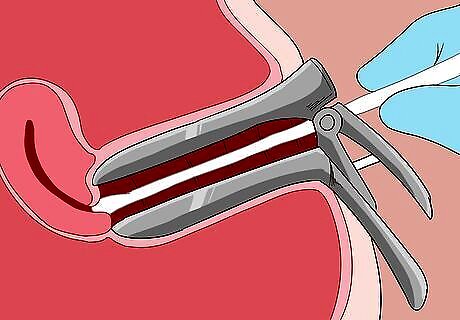
Let them swab your cervix to sample some cells. To take the pap smear, your doctor will insert a long brush or cotton swab into your vagina through the speculum. They’ll use this to gently brush your cervix, which is located at the base of your uterus, far back in your vagina. Depending on how sensitive your cervix is, this might pinch or sting a little bit. It should only take the doctor a few seconds to collect the sample. When they’re done, they’ll loosen the speculum and pull it back out. You should immediately feel a lot more comfortable after that! You might experience a little spotting or light bleeding after the exam. This is totally normal, and should be gone in a day or two.

Be ready for your doctor to do an internal exam with their fingers. After the pap smear, your doctor may use 1 or 2 fingers to feel the inside of your vagina while also pressing down on your lower belly with their other hand. This will help them check the position of your organs and feel for anything unusual, like lumps or masses inside your pelvic area. In some cases, they might also feel inside your rectum. Your doctor will be wearing gloves and will put lubricant on their fingers to make this process more comfortable for you. Once the exam is over, your doctor will step out and give you a few minutes to get dressed. You can also take this opportunity to wipe yourself with tissues or paper towels, since you may be a little messy from the lubricant.
Getting Follow-Up Care

Ask your doctor when you can expect to get your test results. Once the test is done, the doctor will send the cell sample to a lab for testing. It usually takes 1-3 weeks for the test results to come back, but your doctor should be able to give you a more accurate estimate. Ask them if you can expect them to call you or if the results will be posted in an online chart for you to view. If you don’t hear back within 3 weeks, call your doctor’s office and ask about the results.

Schedule a follow-up if there are any abnormal results. Most of the time, pap smear test results come back normal. Sometimes, however, you might get a result of “abnormal” or “unclear.” If this happens, don’t worry! Even an abnormal test result doesn’t necessarily mean that anything is seriously wrong. Talk to your doctor about scheduling a follow-up appointment for further tests. In rare cases, abnormal cells in a pap smear can be a sign of cancer in your cervix or uterus. If your doctor suspects that your test results might indicate a serious problem, they may have you come in for more tests, like a colonoscopy or a biopsy (tissue sample). Sometimes, your doctor will recommend that you wait 6 months to a year and then have another pap smear done. If the abnormal cells are still there or if they see major changes since your last exam, they might decide to do further testing.

Talk to your doctor about when you should get your next pap smear. How often you need to get a pap smear depends on a lot of things, such as your age, your medical history, and how high your risk is for problems like cervical cancer or sexually transmitted infections. Work with your doctor to figure out the best time for you to come in for your next routine pap smear and pelvic exam. Most doctors recommend that you get your first pap smear at age 21, and then follow up every 3 years (or more often if there are abnormal results). Once you’re 30, you can reduce the frequency to once every 5 years unless you have an abnormal pap smear. You can stop having pap smears by the time you’re 65 to 70 as long as you’ve had 3 normal tests within the last 10 years.




















Comments
0 comment